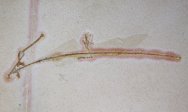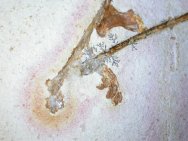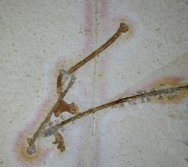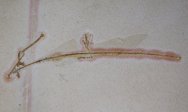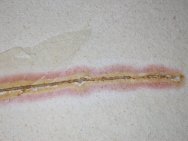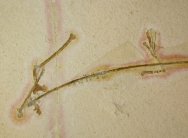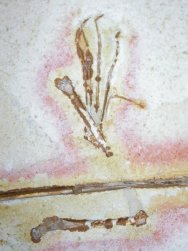Rhamphorynchus
muensteri
Class Sauropsida,
Order Pterosauria, Family Rhamphorynchidae
Geological
Time: Late Jurassic, Kimmeridgian Stage (~150 million years old)
Sizes (25.4mm=1
inch):
Wing (claws to tip); 355 mm
Wing Membrane: 244 mm by 35 mm (as preserved)
Foot 35 mm by 17 mm wide
Tibia: 42 mm
Femur: 33 mm
Radius and Ulna: 65 mm each
Humerus: 37 mm by 17 mm wide
Matrix: 560 mm by 340 mm
Fossil Site:
Solnhofen Plattenkalk, Eichstatt, Germany
Fossil Code:
AAF590
Price: $8950.00
- Sold
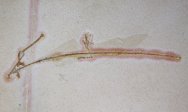 Description:
This spectacular fossil comes from the lithographic limestone Solnhofen
deposits of Germany. These 150 million year old deposits are famous
for their exceptionally well-preserved organisms, the most famous
of which are the handful of specimens of the ancient bird Archaeopteryx.
The specimen shown here was a contemporary of Archaeopteryx, both
temporally and spatially: a Pterosaur, or flying reptile, known as
Rhamphorynchus muensteri. Some 200-300 specimens of this creature
are known, ranging form “flaplings” with a wingspan of
300 mm to old adults in excess of 1.5 meters across. There are 5 named
species of Rhamphorynchus from Solnhofen, but recent research has
shown them to be an ontogenic series of one species: R. Description:
This spectacular fossil comes from the lithographic limestone Solnhofen
deposits of Germany. These 150 million year old deposits are famous
for their exceptionally well-preserved organisms, the most famous
of which are the handful of specimens of the ancient bird Archaeopteryx.
The specimen shown here was a contemporary of Archaeopteryx, both
temporally and spatially: a Pterosaur, or flying reptile, known as
Rhamphorynchus muensteri. Some 200-300 specimens of this creature
are known, ranging form “flaplings” with a wingspan of
300 mm to old adults in excess of 1.5 meters across. There are 5 named
species of Rhamphorynchus from Solnhofen, but recent research has
shown them to be an ontogenic series of one species: R. 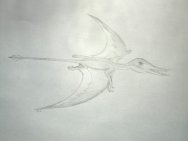 muensteri.
This one would have had a wingspan of almost 1 meter. The elongated
4th (“pinkie”) finger in pterosaurs formed the anchor
for the wing membrane, or muensteri.
This one would have had a wingspan of almost 1 meter. The elongated
4th (“pinkie”) finger in pterosaurs formed the anchor
for the wing membrane, or 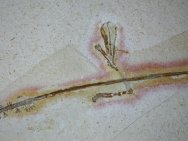 Cheiropatagium,
which extended from the wing tip to the foot. The toe which served
as an anchor in the foot is preserved here pointing away to the right.
A second membrane, the Protopagium, extended from the arm at the claws
to the neck, while a final membrane, the Cruropatagium, extended from
foot to the tail. These surfaces when coupled with the rudderlike
tail of Rhamphorynchus afforded a highly-maneuverable flyer thought
to have been capable of flight almost immediately after hatching.
Nearly all of the bones involved in the flying process are at least
partially preserved in this museum-quality example, the first I have
been able to offer in 7 years. There may be further bones preserved
in the “bump” in the matrix at about the 7 o’clock
position relative to the foot. A single matrix repair can be seen
running longitudinally to the right of the wing claws with a fine
crack running diagonally from the lower left to the right. I recently
obtained this one from an old collection, and seriously doubt that
I will be able to ever replace it. Cheiropatagium,
which extended from the wing tip to the foot. The toe which served
as an anchor in the foot is preserved here pointing away to the right.
A second membrane, the Protopagium, extended from the arm at the claws
to the neck, while a final membrane, the Cruropatagium, extended from
foot to the tail. These surfaces when coupled with the rudderlike
tail of Rhamphorynchus afforded a highly-maneuverable flyer thought
to have been capable of flight almost immediately after hatching.
Nearly all of the bones involved in the flying process are at least
partially preserved in this museum-quality example, the first I have
been able to offer in 7 years. There may be further bones preserved
in the “bump” in the matrix at about the 7 o’clock
position relative to the foot. A single matrix repair can be seen
running longitudinally to the right of the wing claws with a fine
crack running diagonally from the lower left to the right. I recently
obtained this one from an old collection, and seriously doubt that
I will be able to ever replace it. |
|



